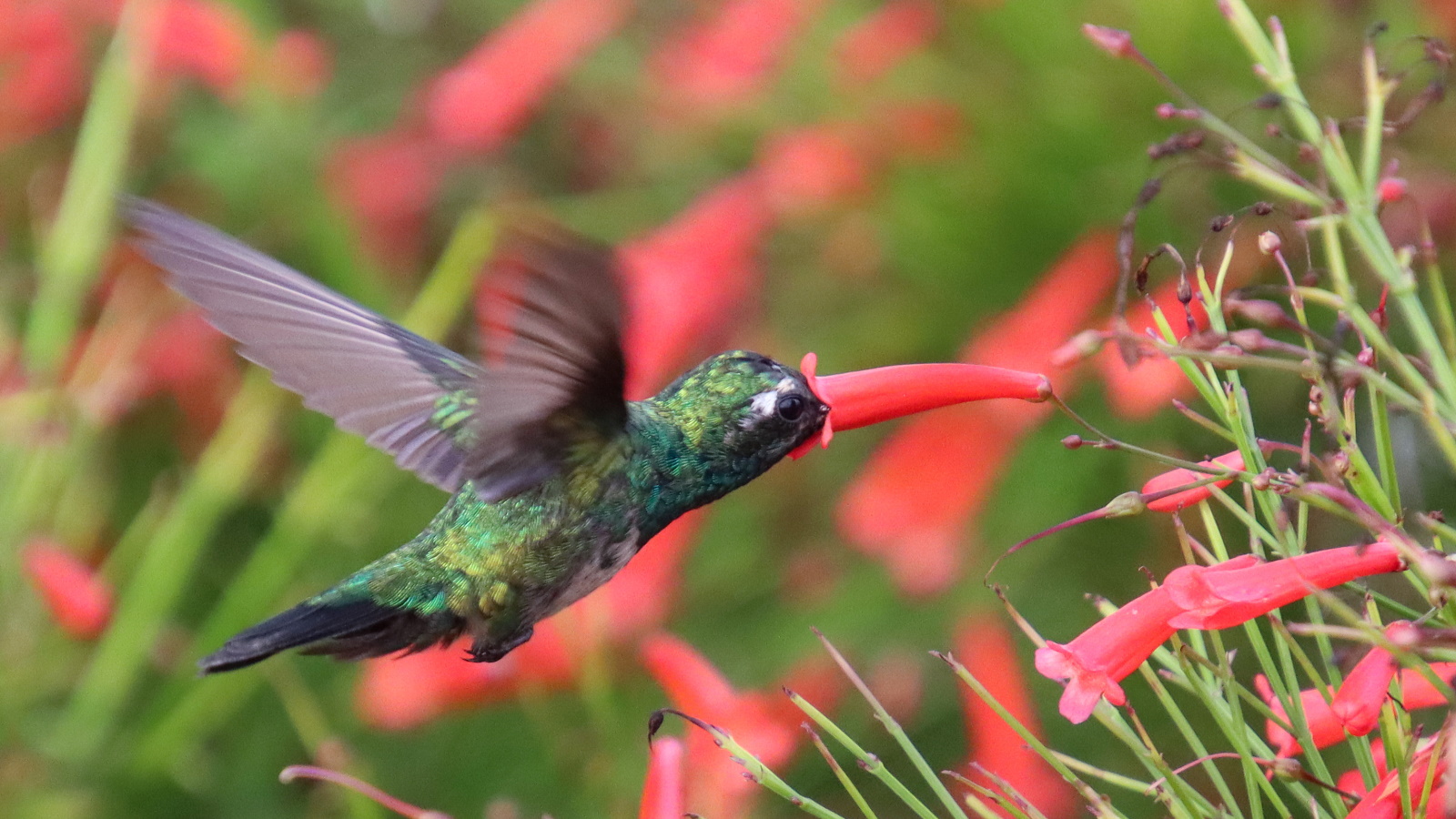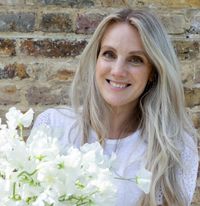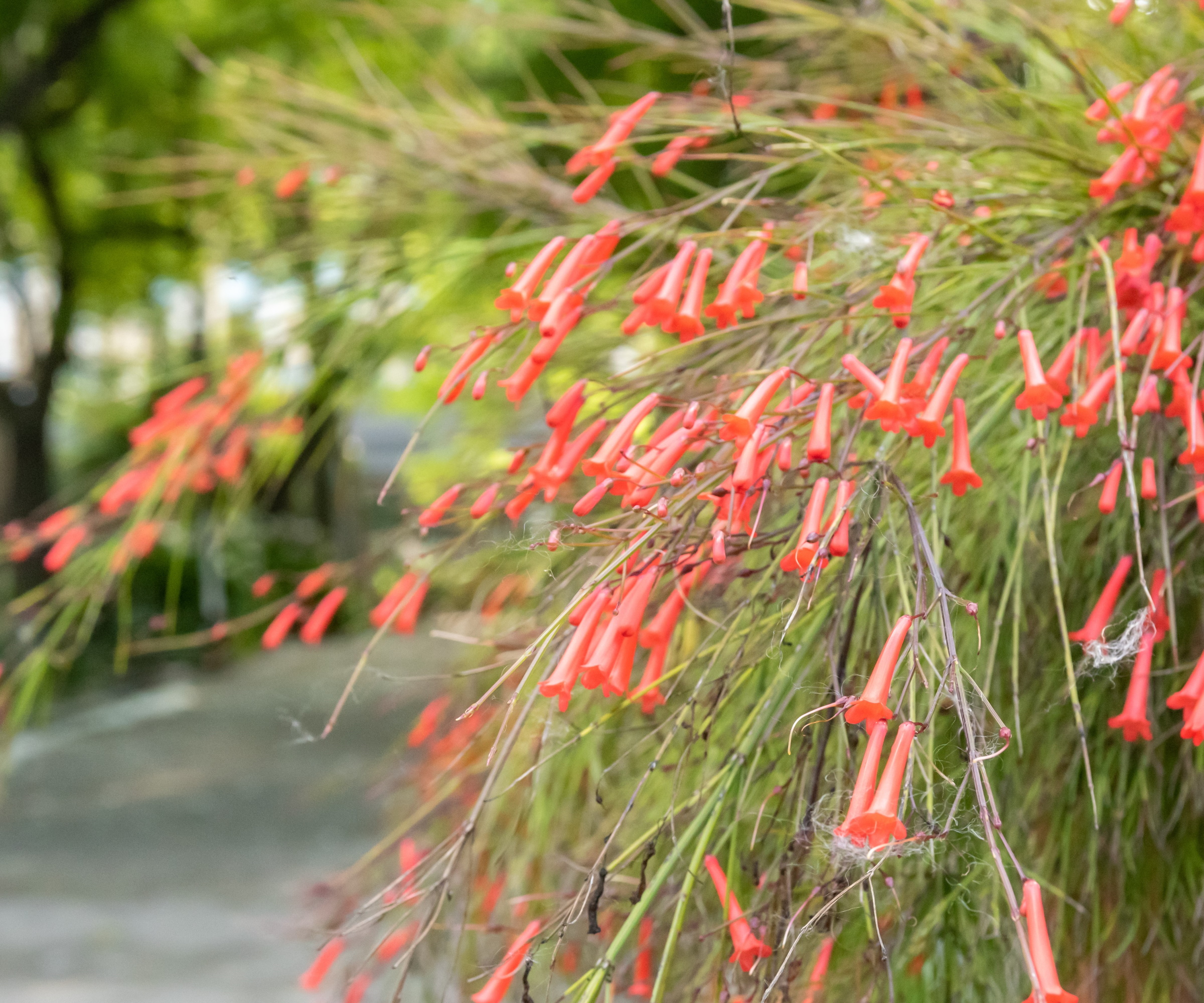How to grow the firecracker plant – for explosive red blooms in your yard
The nectar-rich blooms of the firecracker plant are attractive in any space, plus they are adored by birds and insects


The firecracker plant, Russelia equisetiformis, also known as the coral fountain or the fountain plant, is a unique ornamental shrub with crimson-colored flowers that will brighten up any backyard. The interesting nickname comes from the mass of tubular blooms on a single plant resembling exploding firecrackers.
The tubular shape of the flowers is a common feature of the Plantaginaceae genus, similar to that of the foxglove or the snapdragon flower.
'The flowers of this genus are incredibly popular with hummingbirds,' says Rachel Bull, Head of Gardens at Homes & Gardens. These native birds 'have a preference for flowers with trumpet shapes that have a deep reservoir of nectar.'
Native to Central America, this plant is popular with gardeners for its cascading growth habit and long-lasting blooms, often seen trailing over the garden fence or cascading over walls.
'Firecracker plants are well-suited to a variety of garden settings,' Rachel says. 'They can add vibrant and long-lasting color to borders in the backyard, flower gardens, and container displays near the front porch.'
Their graceful, fountain-like form will undoubtedly create a dramatic and vivid display. Read on to discover how best to grow firecracker plants in your yard, with expert advice on the ideal conditions for optimum blooms.


Rachel is a gardening editor, flower grower and floral designer. Her journalism career began on Country Living magazine, sparking a love of container gardening and wild planting. After more than a decade writing for and editing a range of consumer, business and special interest titles, Rachel became editor of floral art magazine The Flower Arranger. She then trained and worked as a floral designer and stylist in London for six years, before joining the Homes & Gardens team.
How to grow the firecracker plant
Firecracker plants are well-suited to a variety of garden settings and are an easy-to-grow option for the backyard, whether growing in the garden border or in a container display.
Things to know about the firecracker plant

Growing firecracker plants is relatively straightforward as they require minimal maintenance once established. As a native to Central America, including Mexico, it is not surprising to note that these plants adore warm temperatures, growing well in US hardiness zones 8 - 11.
'Firecracker plants thrive in warm locations in full sun to partial shade,' says Autumn Hilliard-Knapp, horticulture specialist at Perfect Plants Nursery. 'For optimal growth and blooming, this plant needs sunshine.'
In cooler zones with lower temperatures, firecracker plants can be grown in containers and overwintered indoors, in a greenhouse for example, to protect them from frost. Just ensure that the container is placed in a position that gets as much sunlight as possible. Once established, firecracker plants are remarkably drought-tolerant, making them suitable options for xeriscaping, where water conservation is a paramount concern when gardening.
The ideal time to 'plant a firecracker plant is in spring after the last frost,' says Autumn. 'It is best to wait until the soil has warmed up to ensure successful establishment.'

Autumn is a plant expert and marketing professional at Perfect Plants Nursery. With four years of experience in the horticulture industry, she has developed a passion for helping people create beautiful indoor and outdoor spaces to enjoy. Her expertise in horticulture encompasses a broad range of activities, including plant care and selection, landscape design, and maintenance.
How to grow the firecracker plant

- Soil: 'The firecracker plant can tolerate a range of soil types,' Autumn says, 'including sandy or loamy soil.' The plant has a preference for a 'slightly acidic to neutral pH level,' Autumn continues. Enhance the soil by incorporating some organic, nutrient-rich compost during planting, such as this planting mix from Perfect Plants. If you reside in a location with alkaline soil, one option is to make the soil more neutral or acidic, using a product such as this soil acidifier from Garden Goods Direct.
- Light: Firecracker plants are tropical plants that 'thrive in full sun to partial shade,' Autumn says, 'preferring at least six hours of direct sunlight each day for optimal growth and blooming.' Whilst this plant will tolerate growing in partial shade, planting in low-light conditions may result in a lack of vibrant trumpet-like flowers.
- Watering: 'When it comes to watering,' Autumn says, 'it is important to keep the soil consistently moist but not waterlogged.' If necessary, mix in drainage material to the soil during planting, such as grit or perlite. 'Water regularly after planting, checking the soil frequently, especially during dry spells,' Autumn says. When watering, do so deeply and thoroughly, allowing the top inch of soil to dry out slightly between waterings, but then soaking the soil. It is recommended to monitor the soil after watering your firecracker plant, to ensure that water can quickly and freely drain away. Remember that the firecracker plant has a preference for dry conditions as a plant native to Central America. It will not respond well to waterlogged soil.
- Fertilizing: The firecracker plant is a prolific flowerer, meaning that it is also a heavy feeder, requiring a good amount of energy and nutrients to maintain the floral performance. Adding a layer of mulch to the soil at the base of the plant every year is a good idea, helping to add nutrients that the plant needs. In addition, use a balanced fertilizer, such as this plant feed from Walmart, applying once a month during the growing season to maintain growth and blooming.
- Pruning: 'The Firecracker plant generally does not require extensive pruning,' Autumn says. However, 'to maintain its shape and promote bushier growth, you can prune it lightly after the blooming season.' It is best to regularly inspect your plant and 'remove any dead or damaged branches,' Autumn says. After the first month of blooming in the spring, it is a good idea to 'pinch back the stems,' encouraging 'branching and more abundant blooms.' Whilst the plant looks attractive when trailing over a wall or hanging down the side of a container, it is preferable to keep the growth bushy and compact, and regular pruning will help to do this.
FAQs
Can I grow the firecracker plant in zone 5?
The ideal growing conditions for the firecracker plant are those found in zones 8, 9, 10 and 11. As a native to Central America, this plant is not frost-hardy and has a preference for hot, dry conditions. However, in cooler zones, such as zone 5, you can grow the firecracker plant, but it is recommended that you do so in a container and protect the plant during the winter months by moving it indoors. Position the container where it will get as much sunlight as possible.
Growing the firecracker plant is a great option to add colorful blooms to your garden or yard. Consider growing other tropical and sub-tropical flowers, such as hibiscus or lantana, that will add even more vibrant flowers and interest to your plot this year.
Sign up to the Homes & Gardens newsletter
Design expertise in your inbox – from inspiring decorating ideas and beautiful celebrity homes to practical gardening advice and shopping round-ups.

Thomas is a Content Editor within the Gardens Team at Homes and Gardens. He has worked as a professional gardener for both public spaces and private estates, specializing in productive gardening, growing food and flowers. Trained in Horticulture at the Garden Museum, he has written on gardening and garden history for various publications, including The English Garden, Gardens Illustrated, Hortus, The London Gardener and Bloom. He has co-authored a Lonely Planet travel book, The Tree Atlas, due out in 2024.
-
 Nectar vs Layla – which mattress brand is best on test?
Nectar vs Layla – which mattress brand is best on test?I've set the Nectar Premier Hybrid Mattress and the Layla Hybrid Mattress head to head to help you work out which mattress meets your needs
By Emilia Hitching Published
-
 Barack and Michelle Obama's neutral accent chair is the perfect living room focal point – you can recreate their serene style in any-sized home
Barack and Michelle Obama's neutral accent chair is the perfect living room focal point – you can recreate their serene style in any-sized homeThis designer-approved essential fits into every modern living room – it's beautiful enough to stand alone, while pairing well with your favorite cushion
By Megan Slack Published